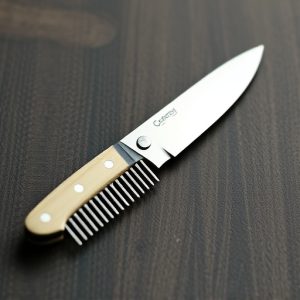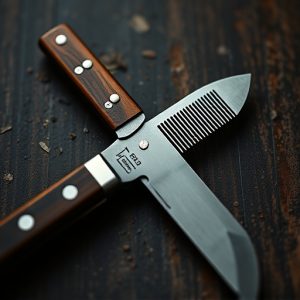Exploring the Mystery and Evolution of the Comb with Hidden Knife
The article delves into the historical and cultural significance of the "comb with hidden knif…….
The article delves into the historical and cultural significance of the "comb with hidden knife," an intriguing Victorian-era artifact that ingeniously combines grooming utility with concealed self-defense. These combs showcase remarkable craftsmanship as they house a hinged knife within their design, blending ornamental elegance with practicality for both aesthetic appeal and discreet protection. The piece explores how these multifunctional items reflect Victorian society's attitudes towards personal safety and the covert integration of defense mechanisms into daily life. It also traces the origins of such designs back to antiquity, through the Renaissance, highlighting their relevance in societies where overt weaponry was prohibited, necessitating the dual use of common objects for personal grooming and self-defense. The modern reinterpretation of these combs emphasizes ergonomic design, enhanced safety features, and a seamless integration of technology, such as fingerprint sensors or voice commands, making them relevant for today's lifestyles as multifunctional accessories that serve both aesthetic and practical purposes. The "comb with hidden knife" thus stands as a testament to human ingenuity, demonstrating how historical motifs can inspire modern solutions that cater to contemporary needs and preferences. Keywords: comb with hidden knife, Victorian-era artifact, historical innovation, personal grooming, self-defense, societal norms, Renaissance artistry, ergonomic design, technological innovations.
Explore the enigmatic allure of the ‘comb with hidden knife,’ a historical artifact that has intrigued and puzzled scholars for centuries. This article delves into the inner workings, cultural relevance, and evolutionary journey of this multifaceted object. From its mysterious mechanisms to its representation across societies, discover how this ancient tool continues to inspire modern innovation and design. Join us as we unravel the secrets behind this unique combination of utility and artistry.
Unveiling the Mechanisms Behind the Comb with Hidden Knife Phenomenon
The “comb with hidden knife” phenomenon, a term often used in discussions about antique combs, particularly those from the Victorian era, refers to the ingenious design where a folding blade or knife is concealed within a comb. This article delves into the intricate mechanisms and craftsmanship that have allowed these combs to maintain both their functional beauty and the secrecy of their hidden blades. The combination of aesthetics and utility in such objects is a testament to the ingenuity of their makers, who utilized a series of precision-engineered components that lock into place when not in use, yet reveal the knife for immediate use when necessary. The blade’s integration into the comb is often achieved through a system of hinges and catches that are both secure and discreet. These combs serve as a remarkable example of historical problem-solving, combining everyday domestic items with elements of defense in a way that would not arouse suspicion or draw undue attention. The study of these artifacts offers insights into the cultural context of their time, reflecting societal norms and expectations regarding personal protection and the roles of household objects.
Historical Context and Origins of the Comb with Hidden Knife Concept
The concept of a comb with a hidden knife, an ingenious design that marries utility and concealment, has its roots deeply embedded in historical practices of self-defense and tool efficiency. Throughout history, individuals from various cultures have sought to combine everyday objects for practical purposes, often driven by the necessity to protect oneself without drawing undue attention or carrying a weapon openly, which was sometimes against the law. The idea of integrating a blade within an object as mundane as a comb can be traced back to periods where social norms were strict about weapon possession, yet self-defense remained a concern. In ancient civilizations such as the Greek and Roman worlds, where the comb was a common personal grooming item, the notion of a concealed weapon within such an object may have been a natural evolution for those who required a discreet means of protection. The design likely evolved to be both functional in its primary purpose—combing hair or beard—and effective as a backup defense mechanism.
The comb with a hidden knife concept regained popularity during the Renaissance, an era marked by political intrigue and societal upheaval. It was a time when bladed weapons were commonplace for noblemen and those in positions of power, often used not just for self-defense but also as a status symbol. The design of such combs reflected the artistry and skill of the period’s blacksmiths and craftsmen, who could fashion a miniature blade with precision to be concealed within the comb’s structure without compromising its use for grooming. The historical context of this design is one of necessity and ingenuity, where the fusion of tools and weapons was a response to social norms and personal safety concerns, showcasing the adaptability of human innovation in response to societal needs.
Anatomy of a Comb with Hidden Knife: Design, Functionality, and Evolution
The “comb with hidden knife,” a multifunctional tool that has garnered attention for its design ingenuity, serves both as an ordinary comb and a concealed blade. This unique item is not merely a curiosity but a testament to human creativity in tool design. Its anatomy is characterized by two distinct components: the outer sheath resembling a standard hair grooming accessory and the inner sharp knife housed discreetly within. The exterior, crafted to blend seamlessly into everyday carry items, often features intricate patterns or a subtle aesthetic that masks its true purpose. The functionality of this device is rooted in its duality; it can be used for routine hair care without raising suspicion, while the knife remains secure and hidden. This design allows for the discreet carry of a cutting tool in settings where such items might otherwise be prohibited or deemed inappropriate.
The evolution of the comb with hidden knife reflects a historical interplay between form and function, as well as cultural shifts in personal adornment and self-defense. Over time, the design has been refined to enhance user safety and the concealment of the blade. Modern iterations often incorporate ergonomic principles to ensure that the comb does not compromise the user’s grip or comfort during use. Additionally, advancements in materials science have led to lighter, stronger, and more durable combinations of metal and plastic, which further refine both the aesthetics and functionality of this concealed weapon. As a result, the comb with hidden knife has become an object of both practical utility and intriguing novelty, appealing to collectors, outdoors enthusiasts, and individuals seeking a discreet self-defense tool.
The Cultural Significance and Representation in Various Societies
The “comb with hidden knife,” an enigmatic motif found in various cultural artifacts and symbolic representations, carries a multitude of meanings across different societies. In some contexts, it represents duality, merging the mundane act of grooming with the concealed readiness for defense or protection. This theme is often depicted in ancient iconography, where the comb could signify order, harmony, and daily care, while the hidden knife symbolizes preparedness, resilience, and a readiness to respond to challenges or threats. The cultural significance of this combination extends to themes of balance, adaptability, and the human condition, reflecting the need to maintain one’s appearance while being aware of the potential for upheaval.
In folklore and mythology, characters or deities wielding a comb with hidden knife embody the idea of harmony within conflict, order amidst chaos, or the balance between peace and preparedness for strife. This imagery underscores the importance of being both civilized and vigilant, an ethos that resonates in various societies as a reminder of the complexities of life and the necessity to navigate social and environmental landscapes with care. The representation of this motif varies, but it consistently symbolizes an individual’s or community’s ability to manage daily life while being prepared for the unexpected, a concept deeply rooted in the human experience across cultures.
Modern Interpretations and Innovations in the Comb with Hidden Knife Concept
The “comb with hidden knife” concept, steeped in historical contexts, has been reimagined and modernized in various creative and functional ways across different industries. In the realm of everyday objects, designers have innovated this ancient tool into multifunctional accessories that blend seamlessly into contemporary lifestyles. These modern iterations often feature a discreet compartment or mechanism where the knife is concealed within the comb’s structure, ensuring safety while maintaining the tool’s dual functionality. The design of these combs prioritizes ergonomics and aesthetics, making them practical for personal grooming while also providing a hidden defense mechanism.
Furthermore, the concept has transcended its traditional boundaries, influencing product designers and engineers to explore its potential in fields such as survival gear, self-defense tools, and even in the realm of high-tech gadgets. Insurmountable advancements in materials science have allowed for the creation of combs with hidden knives that are both lighter and more durable. Additionally, technological integration has led to smart comb designs where the knife can be deployed via a simple fingerprint sensor or voice command, catering to the modern user’s desire for seamless and intuitive experiences. These cutting-edge (pun intended) combinations of form and function exemplify how historical designs can inspire innovative solutions that resonate with current needs and preferences.


